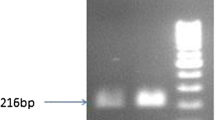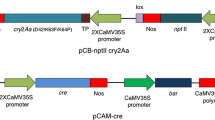Abstract
A hybrid δ-endotoxin protein was designed against a polyphagous lepidopteran insect pest Spodoptera litura, which is tolerant to most of the known δ-endotoxins. The hybrid δ-endotoxin was created by replacing amino acid residues 530–587 in a poorly active natural Cry1Ea protein, with a highly homologous 70 amino acid region of Cry1Ca in domain III. The truncated δ-endotoxins Cry1Ea, Cry1Ca and the hybrid protein Cry1EC accumulated in Escherichia coli to form inclusion bodies. The solubilised Cry1EC made from E. coli was 4- fold more toxic to the larvae of S. litura than Cry1Ca, the best known δ-endotoxin against Spodoptera sp. None of the two truncated toxins, solubilised from E. coli caused larval mortality. However, trypsinised Cry1Ca protoxin obtained from E. coli and solubilised from inclusion bodies caused mortality of S. litura with LC50 513 ng/ml semi synthetic diet. A synthetic gene coding for the hybrid$-endotoxin Cry1EC was designed for high level expression in plants, taking into consideration several features found in the highly expressed plant genes. Transgenic, single copy plants of tobacco as well as cotton were developed. The selected lines expressed Cry1EC at 0.1–0.7% of soluble leaf protein. Such plants were completely resistant to S. litura and caused 100% mortality in all stages of larval development. Hence, unlike in E. coli, the hybrid δ-endotoxin folded into a functionally active conformation in both tobacco and cotton leaves. The truncated Cry1EC expressed in tobacco leaves was about 8-fold more toxic (LC50 58 ng/ml diet) compared to expression in E. coli.
Similar content being viewed by others

References
Aronson AI, Wu D and Zhang C (1995) Mutagenesis of specificity and toxicity regions of a Bacillus thuringiensis protoxin gene. J Bacteriol 177: 4059-4065.
Bai C, Degheele D, Jansens S and Lambert B (1993) Activity of insecticidal proteins and strains of Bacillus thuringiensis against Spodoptera exempta (Walker). J Inverteb Pathol 62: 211-215.
Ballester V, Granero F, de Maagd RA, Bosch D, Mènsua JL and Ferrè J (1999) Role of Bacillus thuringiensis toxin domains in toxicity and receptor binding in the diamondback moth. Appl Environ Microbiol 65: 1900.
Bosch D, Schipper B, van der Klei H, de Maagd RA and Stiekema WJ (1994) Recombinant Bacillus thuringiensis crystal proteins with new properties: possibilities for resistance management. Bio/Tech 12: 915-918.
Bosse M, Masson L and Brousseau R (1990) Nucleotide sequence of a novel crystal protein gene isolated from Bacillus thuringiensis supspecies kenyae. Nucleic Acids Res 18: 7443.
Chambers JA, Jelen A, Gilbert MP, Jany CS, Johnson TB and Gawron-Burke C (1991) Isolation and characterization of a novel insecticidal crystal protein gene from Bacillus thuringiensis subsp. aizawai. J Bacteriol 173: 3966-3976.
Chandra A, Ghosh P, Mandaokar AD, Bera AK, Sharma RP, Das S et al. (1999) Amino acid substitution in alphahelix 7 of CryIAc delta-endotoxin of Bacillus thuringiensis leads to enhanced toxicity to Helicoverpa armigera Hubner.FEBS Lett 458: 175-179.
Chen XJ, Curtiss A, Alcantara E and Dean DH (1995) Mutations in domain I of Bacillus thuringiensis d-endotoxin Cry1Ab reduce the irreversible binding of toxin to Manduca sexta brush border membrane vesicles. J Biol Chem 270: 6412-6419.
Crickmore N, Zeigler DR, Feitelson J, Schnepf E, Van Rie, J Lereclus et al. (1998) Revision of the nomenclature for the Bacillus thuringiensis pesticidal crystal proteins. Microbiol Mol Biol Rev 62: 807-813.
de Maagd RA, Kwa MS, van der Klei H, Yamamoto T, Schipper B, Vlak JM et al. (1996) Domain III substitution in Bacillus thuringiensisdelta-endotoxin CryIA(b) results in superior toxicity for Spodoptera exigua and altered membrane protein recognition. Appl Environ Microbiol 62(5): 1537-1547.
de Maagd RA, Bakker P, Staykov N, Dukiandjiev S, Stiekema W and Bosch D (1999) Identification of Bacillus thuringiensis delta-endotoxoin Cry1C domain III amino acid residues involved in insect specificity. Appl Environ Microbiol 65: 4369-4374.
de Maagd RA, Weemen-Hendriks M, Molthoff JW and Naimov S (2003) Activity of wild-type and hybrid Bacillus thuringiensis δ-endotoxins against Agrotis ipsilon. Arch Micro 179: 363-367.
de Maagd RA, Weemen-Hendriks M, Stiekema W and Bosch D (2000) Bacillus thuringiensis delta-endotoxin Cry1C domain III can function as a specificity determinant for Spodoptera exigua in different, but not all, Cry1-Cry1C hybrids. Appl Environ Microbiol 66: 1559-1563.
Gill SS, Cowles EA and Pietrantonio PV (1992) The mode of action of Bacillus thuringiensis endotoxins. Ann Rev Entomol 37: 615-636.
Grochulski P, Masson L, Borisova S, Pusztai-Carey M Schwartz, J-L Brousseau R and Cygler M (1995) Bacillus thuringiensis CryIA(a) insecticidal toxin: crystal structure and channel formation. J Mol Biol 254: 447-464.
Harlow Ed and Lane D (1999) Using Antibodies: A Laboratory Manual. Cold Spring Harbor Laboratory.
Hofte H and Whiteley HR (1989) Insecticidal crystal protein of Bacillus thuringiensis. Microbiol Rev 53: 242-255.
Honée G, Vriezen W and Visser B (1990) A translation fusion product of two different insecticidal crystal protein gene of Bacillus thuringiensis exhibits an enlarged insecticidal spectrum. Appl Environ Microbiol 56: 823-825.
Honée G, Convents D, Rie JV, Jansens S, Peferoen M and Visser B (1991) The C-terminal domain of the toxic fragment of Bacillus thuringiensis crystal protein determines receptor binding. Mol Microbiol 5: 2799-2806.
Honée G, van der Salm T and Visser B (1988) Nucleotide sequence of crystal protein gene isolated from B. thuringiensis subspecies entomocidus 60.5 coding for a toxin highly active against. Spodoptera species Nucleic Acids Res 16: 6240.
Horsch RB, Fraley RT, Rogers SG, Sander PR, Lloyd A and Hoftman N (1984) A simple and general method of transferring genes into plants. Science 223: 496-498.
Kalman S, Kiehne KL, Libs JL and Yamamoto T (1993) Cloning of a novel cryIC-type gene from a strain of Bacillus thuringiensis subsp. galleriae. Appl Environ Microbiol 59: 1131-1137.
Kay R, Chan A, Daly M and McPherson J (1987) Duplication of CaMV 35S promoter sequences creates a strong enhancer for plant genes. Science 236: 1299-1302.
Keller M, Sneh B, Strizhov N, Prudovsky E, Regev A, Koncz C et al. (1996) Digestion of d-endotoxin by gut proteases may explain reduced sensitivity of advanced instar larvae of Spodoptera littoralis to CryIC. Insect Biochem Mol Biol 26: 365-373.
Lambert B, Buysse L, Decock C, Jansens S, Piens C, Saey B et al. (1996) A Bacillus thuringiensis insecticidal crystal protein with a high activity against members of the family noctuidae. Appl Environ Microbiol 62: 80-86.
Li J, Carroll J and Ellar DJ (1991) Crystal structure of insecticidal δ-endotoxin from Bacillus thuringiensis at 2.5 Å resolution. Nature 353: 815-821.
Masson L, Moar WJ, van Frankenhuyzen K, Bosse M and Brousseau R (1992) Insecticidal properties of a Crystal protein gene product isolated from Bacillus thuringiensis subsp. kenyae. Appl Environ Microbiol 58(2): 642-646.
Mazier M, Chaufaux J, Sanchis V, Lereclus D, Giband M and Tourneur J (1997) The cryIC gene from Bacillus thuringiensis provides protection against Spodoptera littoralis in young transgenic plants. Plant Sci 127: 179-190.
Naimov S, Dukiandjiev S and de Maagd RA (2003) A hybrid Bacillus thuringiensis delta-endotoxin gives resistance against a coleopteran and a lepidopteran pest in transgenic potato. Plant Biotech J 1: 51-57.
Naimov S, Weeman-Hendriks M, Dukiandjiev S and de Maagd RA (2001) Bacillus thuringiensis delta-endotoxin Cry1 hybrid proteins with increased activity against the Colorado potato beetle. Appl Environ Microbiol 67: 5328-5330.
Nishimoto T, Yoshisue H, Ihara K, Sakai H and Komano T (1994) Functional analysis of block 5, one of the highly conserved amino acid sequences in the 130 kDa CryIVa protein produced by Bacillus thuringiensis subsp. israelensis. FEBS Lett 348: 249-254.
Perlak FJ, Oppenhuizen M, Gustafson K, Voth R, Sivasupramaniam S, Heering D et al. (2001) Development and commercial use of Bollgard cotton in the USA-early promises versus today's reality. Plant J 27: 489-501.
Rajamohan F, Alzate O, Cotrill JA, Curtiss A and Dean DH (1996) Protein engineering of Bacillus thuringiensis d-endotoxin: mutations at domain II of Cry1Ab enhance receptor affinity and toxicity toward gypsy moth larvae. Proc Natl Acad Sci USA 93: 14338-14343.
Rang C, Vachon V, de Maagd RA, Villalon M, Schwrtz J-L, Bosch D et al. (1999) Interaction between functional domains of Bacillus thuringiensis insecticidal crystal protein. Appl Environ Microbiol 65: 2918-2925.
Sambrook J, Fritsch EF and Maniatis T (1989) Molecular Cloning: A Laboratory Mannual. Cold Spring Harbor Laboratory Press, Cold Spring Harbor, New York.
Sanchis V, Lereclus D, Menou G, Chaufaux J and Lecadet M-M (1988) Multiplicity of d-endotoxin genes with different insecticidal specificities in Bacillus thuringiensis aizawai 7.29. Mol Microbiol 2: 393-404.
Sawant SV, Kiran K, Singh PK and Tuli R (2001) Sequence architecture downstream of the initiator codon enhances gene expression and protein stability in plants. Plant Physiology 126: 1630-1636.
Sawant SV, Singh PK, Gupta SK, Madanala R and Tuli R (1999) Conserved nucleotide sequences in highly expressed genes in plants. J Genet 78: 123-131.
Schnepf E, Crickmore N, Rie JV, Lereclus D, Baum J, Feitelson J et al. (1998) Bacillus thuringiensis and its pesticidal crystal proteins. Microbiol Mol Biol Rev 62: 775-806.
Selvapandiyan A, Reddy VS, Kumar PA, Tewari KK and Bhatnagar RK (1998) Transformation of Nicotiana tabacum with a native cry1Ia5 gene confers complete protection against Heliothis armigera. Mol Breeding 4: 473-478.
Singh PK, Sarangi BK and Tuli R(1996) A facile method for the construction of synthetic genes. J Biosc 21: 735-741.
Strizhov N, Keller M, Mathur J, Koncz-Kalman Z, Bosch D, Prudovsky E et al. (1996) A synthetic cryIC gene, encoding a Bacillus thuringiensis d-endotoxin, confers Spodoptera resistance in alfalfa and tobacco. Proc Natl Acad Sci USA 93: 15012-15017.
Sunilkumar G and Rathore KS (2001) Transgenic cotton: Factors influencing Agrobacterium mediated transformation and regeneration. Mol Breed 8: 37-52.
Von Tersch MA, Robbins HL, Jany CS and Johnson TB (1991) Insecticidal toxins from Bacillus thuringiensis subsp. kenyae: gene cloning and characterization and comparison with B. thuringiensis subsp. kurstaki CryIAI toxins. Appl Environ Microbiol 57: 349-358.
Visser B, Munsterman E, Stoker A and Dirkse WG (1990) A novel Bacillus thuringiensis gene encoding a Spodoptera exigua-specific crystal protein. J Bacteriol 172: 6783-6788.
Wolfersberger MG, Chen XJ and Dean DH (1996) Site directed mutations in the third domain of Bacillus thuringiensis δ-endotoxin Cry1Aa affect its ability to increase the permeability of Bombyx mori midgut brush border membrane vesicles. Appl Environ Microbiol 62: 279-282.
Author information
Authors and Affiliations
Rights and permissions
About this article
Cite this article
Singh, P., Kumar, M., Chaturvedi, C. et al. Development of a hybrid delta-endotoxin and its expression in tobacco and cotton for control of a polyphagous pest Spodoptera litura . Transgenic Res 13, 397–410 (2004). https://doi.org/10.1007/s11248-004-4908-7
Issue Date:
DOI: https://doi.org/10.1007/s11248-004-4908-7



